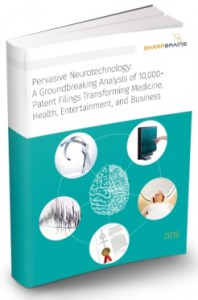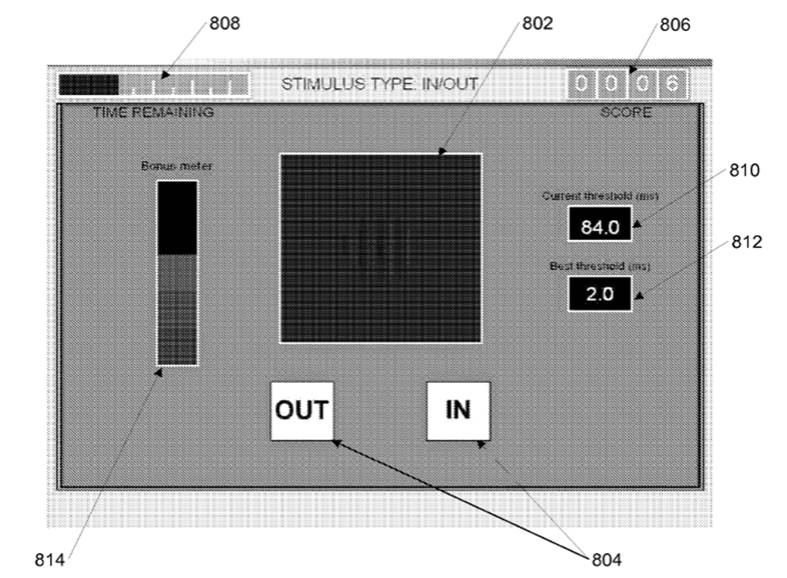Addressing aging-related cognitive decline via targeted training using visual sweeps: Key neurotech patent by Posit Science
Today we are featuring a 2012 patent by Posit Science Corporation, the developer of BrainHQ cognitive training system.
U.S. Patent No. 8,215,961: Cognitive training using visual sweeps
- Assignee(s): Posit Science Corporation
- Inventor(s): Michael M. Merzenich, Peter B. Delahunt, Joseph L. Hardy, Stephen G. Lisberger, Henry W. Mahncke
- Technology Category: Neurocognitive training
- Issue Date: July 10, 2012
SharpBrains’ Take:
The background of the ‘961 patent describes the decline in cognitive function associated with aging, such as the reduced ability to comprehend and respond to stimulus. For example, the reconstruction of an order in which objects (of varying size, color, type, etc.) are presented may generally be less accurate by an older individual in the last decades of his/her natural lifespan as compared to that same individual when they were in their 20’s. The teachings of the ‘961 patent aim to provide software training to preserve and improve cognitive tasks as they apply to “real-world” behavioral abilities. A series of distinct patterns, such as two patterns with differing frequencies as shown in the illustrative image above (“in” being a higher frequency pattern and “out” being a lower frequency pattern), are iteratively presented to the user so that the user may differentiate between the two patterns and thereby train recognition abilities.
The interesting approach to cognitive training (i.e., pattern recognition/differentation) along with a substantial claim set (45 in total) that includes a “picket-fence” of independent claims (seven in total) are amongst the factors making the ‘961 patent a key non-invasive neurotechnology patent.
Abstract:
A computer-implemented method for enhancing cognitive ability of an older participant by requiring the participant to differentiate between rapidly presented visual stimuli. First and second visual sweeps are provided for visual presentation to the participant, e.g., spatial frequency or orientation sweeps. At least two visual sweeps are visually presented to the participant utilizing the first visual sweep, the second visual sweep, or a combination. The participant is required to indicate an order in which the at least two visual sweeps were presented. A determination is made regarding whether the participant indicated the order of the visual sweeps correctly. The visually presenting, requiring, and determining are repeated one or more times in an iterative manner to improve the participant’s cognition. The duration of the sweeps may be adjusted based on the correctness/incorrectness of the participant’s response according to a maximum likelihood procedure. Assessments may be made during the exercise.
Illustrative Claim 10. A method for successively stimulating a variety of preferentially tuned neurons in the early visual cortex to enhance visual sensory processing and cognition in a participant, utilizing a computing device to present visual stimuli training exercises based on visual sweeps, and to record responses from the participant, the method comprising:
- providing first and second spatial frequency sweeps, wherein the first spatial frequency sweep comprises a sweep pattern that increases in frequency over time, and wherein the second spatial frequency sweep comprises a sweep pattern that decreases in frequency over time, and wherein the first and second visual sweeps are available for visual presentation to the participant;
- sequentially visually presenting at least two spatial frequency sweeps to the participant utilizing either the first spatial frequency sweep, the second spatial frequency sweep, or a combination of the first and second spatial frequency sweeps;
- requiring the participant to indicate an order in which the at least two spatial frequency sweeps were presented;
- the computing device determining whether the participant indicated the order of the at least two spatial frequency sweeps correctly; and
- repeating said sequentially visually presenting, said requiring, and said determining one or more times in an iterative manner to improve the participant’s cognition.
 To learn more about market data, trends and leading companies in the digital brain health space –digital platforms for brain/ cognitive assessment, monitoring and enhancement– check out this market report. To learn more about our analysis of 10,000+ patent filings, check out this IP & innovation neurotech report.
To learn more about market data, trends and leading companies in the digital brain health space –digital platforms for brain/ cognitive assessment, monitoring and enhancement– check out this market report. To learn more about our analysis of 10,000+ patent filings, check out this IP & innovation neurotech report.



